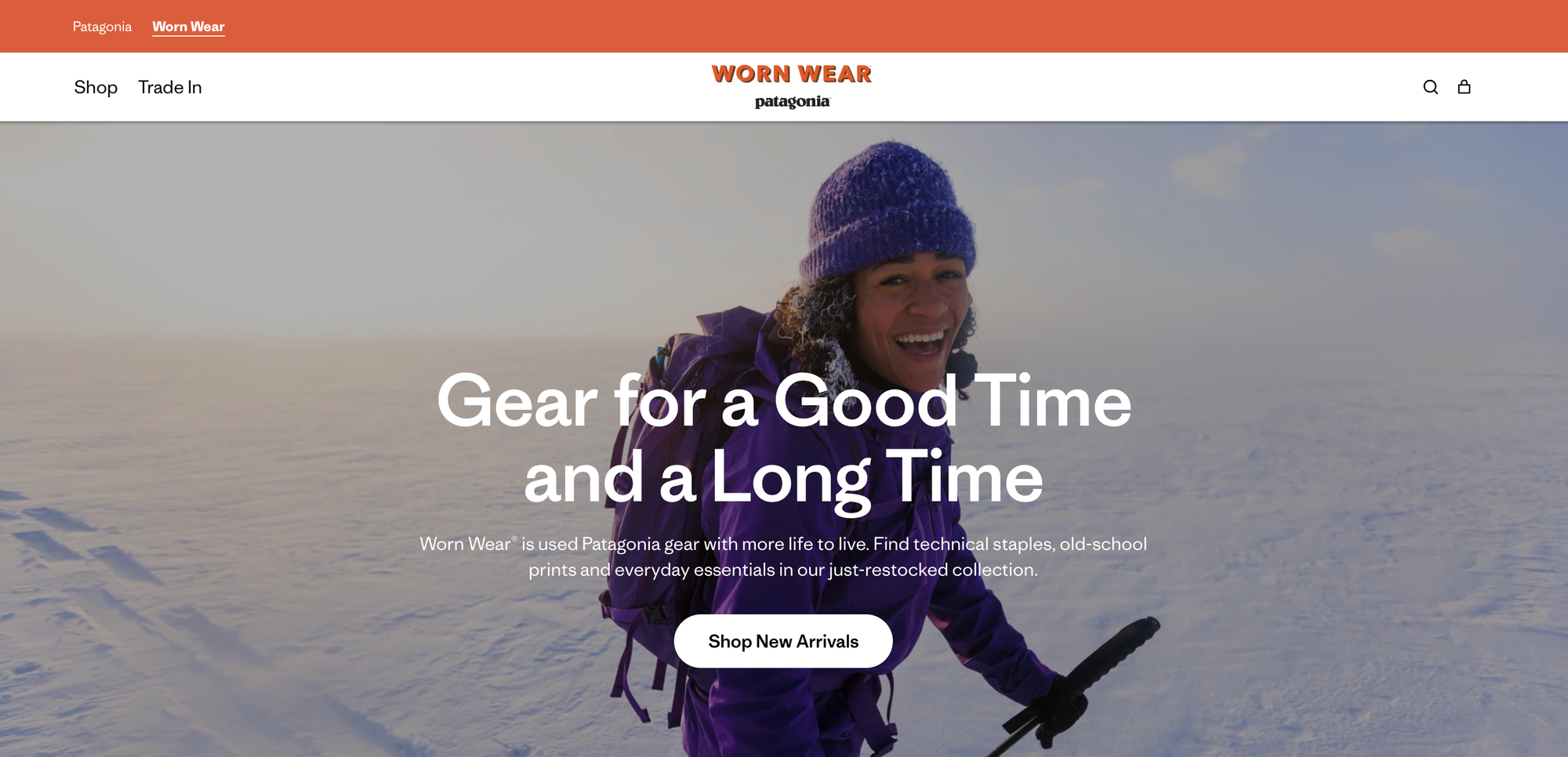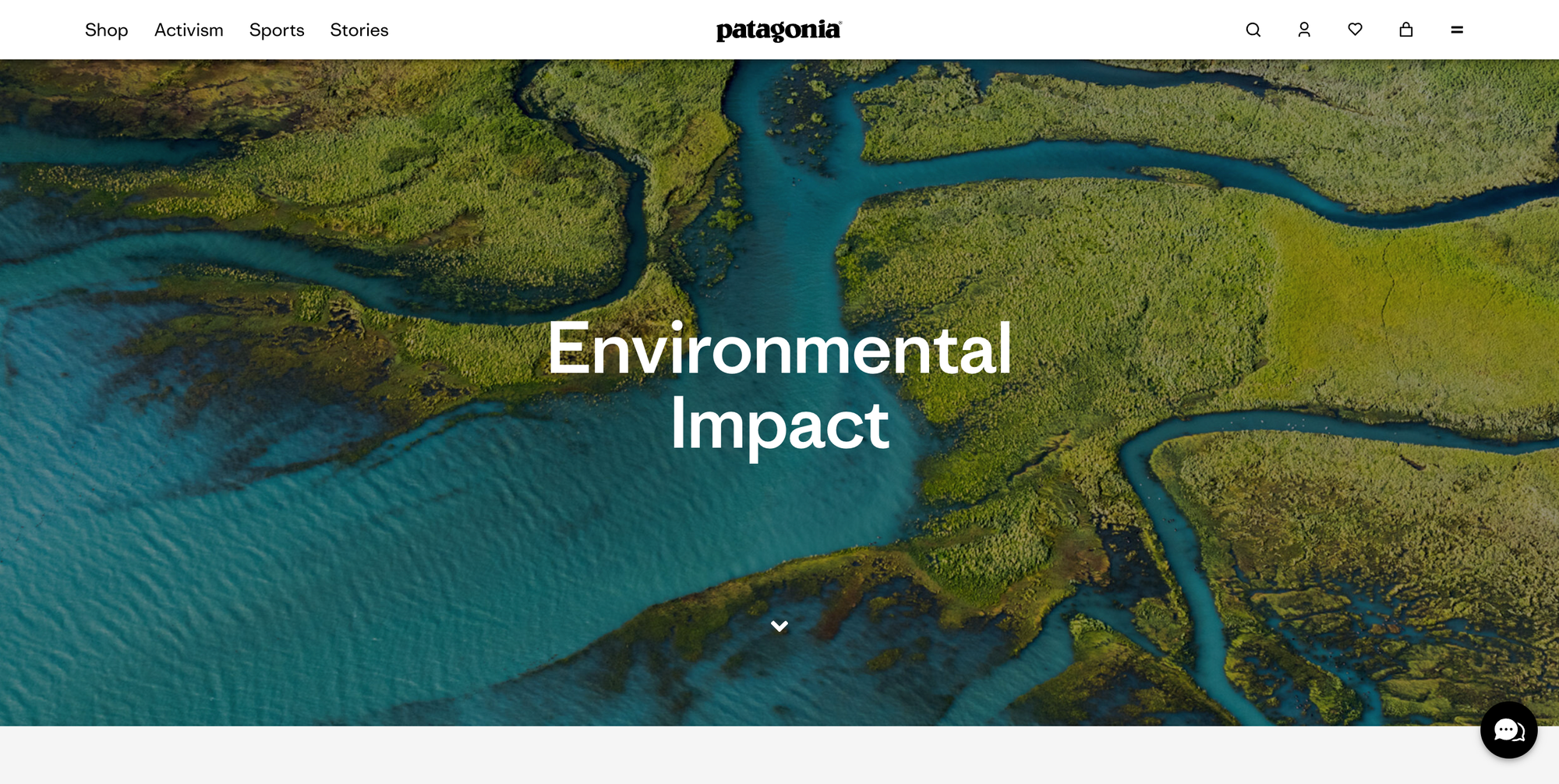Patagonia is an outdoor clothing and gear company renowned for its high-quality products and unwavering commitment to environmental and social responsibility.
Its mission statement, "We're in business to save our home planet," permeates every aspect of its operations, positioning it as a leader in purpose-driven business.
The company operates within the impact sector by actively working to minimize its environmental footprint, promote fair labor practices, and inspire other companies to do the same.
This case study aims to explore Patagonia's unique business model, its deep-rooted impact strategy, and the lessons it offers for businesses seeking to integrate purpose with profit.
Readers will gain insights into how Patagonia has successfully balanced financial success with a profound commitment to environmentalism and social justice, navigating challenges and setting a powerful example for responsible corporate citizenship.
Founding Story

Patagonia's story began in the late 1950s with Yvon Chouinard, a passionate rock climber who started making his own reusable climbing hardware because the existing gear was damaging the rocks.
This evolved into Chouinard Equipment, which became known for its innovative and durable climbing gear. By the late 1960s, Chouinard also started selling rugby shirts and other clothing suitable for outdoor adventures.
Recognizing the environmental impact of his businesses, Chouinard shifted his focus, leading to the incorporation of Patagonia in 1973, named after the rugged region of South America.
His personal ethos of simplicity, quality, and environmental stewardship became the bedrock of the company.
Vision and Mission
Patagonia's core vision is to use its business to inspire and implement solutions to the environmental crisis. Its mission, "We're in business to save our home planet," is not just a tagline but a guiding principle that informs every decision, from product design and material sourcing to political activism and philanthropic giving.
Initial Challenges
In its early days, Patagonia faced typical startup challenges related to funding, production, and establishing brand recognition.
However, a significant early challenge stemmed from Chouinard's unconventional approach to business, prioritizing quality and durability over planned obsolescence, which went against prevailing consumerism trends.
Balancing this commitment with the need for profitability required careful navigation and a loyal customer base that valued these principles.
Business Model

Revenue Streams
Patagonia primarily generates revenue through the sale of its outdoor clothing, gear for climbing, hiking, skiing, snowboarding, surfing, fly fishing, and trail running, as well as workwear and food products under Patagonia Provisions.
Revenue also comes from its used gear platform, Worn Wear, which promotes product longevity and reduces waste.
Patagonia's E-commerce
While Patagonia's commitment to the planet is tangible in their brick-and-mortar stores – often hubs for community and repair services – their online presence is a powerhouse of its own.
Recent data underscores just how significant their e-commerce operation has become. According to insights from Grips Intelligence, a platform specializing in e-commerce analytics, patagonia.com generated a staggering revenue of over $52 million in February 2025.
The success of patagonia.com further amplifies the brand's ability to achieve its overarching goals. The significant revenue generated online provides crucial resources to fuel their environmental initiatives, support fair labor practices, and continue pushing for a more sustainable future.
It's a powerful reminder that in today's landscape, a thriving e-commerce platform can be a vital engine for a company striving to make a positive impact on the world.
Value Proposition
Patagonia offers high-quality, durable, and functional products designed for outdoor enthusiasts. What sets it apart is its unwavering commitment to environmental and social responsibility, which resonates deeply with its target market.
Customers are not just buying a product; they are supporting a company that aligns with their values and actively works to protect the planet. The brand's transparency regarding its supply chain and environmental impact further enhances its value proposition.
Target Market
Patagonia's primary target market consists of outdoor enthusiasts who are passionate about environmental conservation and social responsibility. These customers value quality, durability, and sustainability and are often willing to pay a premium for products from a company they trust.
The market also includes individuals who appreciate the brand's ethical stance and commitment to making a positive impact.
Impact Strategy
Goals and Objectives
Patagonia's impact goals are multifaceted and deeply integrated into its business operations. Key objectives include:
- Minimizing its environmental footprint through responsible sourcing of materials (e.g., organic cotton, recycled materials), reducing waste, and lowering carbon emissions.
- Promoting fair labor practices and safe working conditions throughout its supply chain.
- Supporting grassroots environmental organizations through financial grants and in-kind donations.
- Advocating for environmental protection and conservation through public awareness campaigns and political activism.
- Encouraging product longevity and repair through its Worn Wear program.
Implementation Plan
Patagonia implements its impact strategy through various concrete actions:
- Material Innovation: Investing in and prioritizing the use of environmentally preferred materials like organic cotton and recycled polyester.
- Supply Chain Transparency: Working closely with suppliers to ensure fair labor practices and environmental standards, and publicly disclosing its supply chain.
- 1% for the Planet: Donating 1% of its sales to grassroots environmental organizations. Learn more
- Patagonia Action Works: Connecting customers with local environmental volunteer opportunities and events.
- Worn Wear Program: Offering repair services, selling used gear, and providing resources for product care to extend the life of its products.
- Advocacy: Engaging in political activism and public campaigns to advocate for environmental policies.

Partnerships and Collaborations
Patagonia collaborates with numerous organizations to amplify its impact, including:
- Environmental Non-profits: Providing funding and support to a wide range of grassroots environmental groups.
- Fair Labor Association: Working to ensure fair labor practices in its supply chain.
- Bluesign Technologies: Partnering to ensure the responsible and sustainable manufacturing of textiles.
- Other Businesses: Collaborating on initiatives to promote sustainable business practices across industries.
Achievements and Milestones
1985: Began donating 1% of sales to environmental groups.
1996: Switched to using only organically grown cotton in its clothing.
2011: Launched the Common Threads Initiative, emphasizing reduce, repair, reuse, recycle, and reimagine.
2013: Became a certified B Corporation, meeting rigorous standards of social and environmental performance, accountability, and transparency.
2018: Updated its mission statement to "We're in business to save our home planet."
2022: Founder Yvon Chouinard and his family transferred ownership of the company to two new entities: the Patagonia Purpose Trust and the Holdfast Collective, ensuring that all of Patagonia's profits will be used to fight the climate crisis and protect undeveloped land.
Impact Metrics
- Donated over $150 million to environmental groups through its 1% for the Planet commitment.
- Significantly reduced its use of virgin petroleum-based materials by increasing the use of recycled content.
- Supported numerous fair labor initiatives and improved working conditions in its supply chain.
- Diverted significant amounts of clothing from landfills through its Worn Wear program.
- Engaged millions of customers in environmental activism through Patagonia Action Works.

Impact Case Examples
- Patagonia's long-standing support for grassroots environmental groups has enabled them to protect vital ecosystems and fight against harmful industrial practices. For example, their funding has been crucial in campaigns to protect wild rivers and old-growth forests.
- The Worn Wear program has not only extended the life of Patagonia products but has also fostered a culture of mindful consumption among its customers. Stories abound of well-loved Patagonia gear being repaired and passed down through generations, reducing the need for new purchases.
- Patagonia's public stance against certain political decisions and its active participation in environmental campaigns have raised awareness and inspired others to take action on climate change and conservation issues.
Causeartist BackOffice
Your Mission-Aligned Operations Team
From investor-ready financials to growth strategy, HR, compliance, and custom software—Causeartist BackOffice is your all-in-one operational partner. Built for impact startups, funds, and nonprofits, and powered by our experts.
Let us handle the back office—so you can stay focused on impacting the world.
Patagonia Financial Overview
Revenue Growth and Recent Annual Figures
Patagonia has grown from a niche outdoor gear maker into a billion-dollar enterprise over the past decades. As a privately held company, it does not publicly release detailed financial statements, but credible estimates and statements from leadership give a picture of its revenue trajectory.
Annual sales have consistently exceeded $1 billion in recent years
In fact, Patagonia’s revenues reached roughly $1.5 billion in 2022 – a significant jump compared to the ~$1 billion level of the late 2010s.
This growth continues a long-term trend: Patagonia’s sales have expanded steadily over time, roughly tripling from around $200 million in the early 2000s to $600 million by 2012, and then quadrupling over the subsequent decade to about $1 billion by 2019. The table below summarizes key revenue estimates for select years:
| Year | Estimated Annual Revenue (USD) |
|---|---|
| 2012 | ~$600 million |
| 2017 | ~$800 million |
| 2019 | ~>$1 billion |
| 2020 | ~>$1 billion (slight pandemic dip) |
| 2021 | ~>$1 billion (slight dip vs. 2020) |
| 2022 | ~$1.5 billion |
Table: Patagonia’s annual revenue estimates. (2019–2021 revenues were each above $1 billion, though growth stalled during the pandemic. Figures are rounded as the company does not publicly disclose exact revenues.)
Profitability and Profit Margins
Profit margins at Patagonia are healthy, reflecting its premium positioning and efficient operations. While precise financials are private, the company is known for high gross margins in its industry.
A Harvard case study noted Patagonia’s gross profit margin was on the order of 50–55% of sales
At the net profit level, Patagonia is solidly profitable but prioritizes reinvestment and responsible business practices over maximizing earnings. Recent estimates put annual net profit around $100 million
Indeed, when Patagonia’s founder transferred ownership in 2022, the company projected it would be able to “pay out an annual dividend of roughly $100 million” to its new nonprofit owner, after reinvesting in the business.
On roughly $1.5 billion in revenue, this implies a net profit margin on the order of ~6–7%. Some observers have suggested Patagonia’s profit margin could be as high as ~10% in strong years, but management has not confirmed a specific figure. What is clear is that Patagonia generates significant positive earnings each year.
Notably, Patagonia has long voluntarily sacrificed a portion of profit for environmental causes. Since 1985 the company has donated 1% of sales each year to grassroots environmental nonprofits.
This equates to roughly $10–15 million in grants annually in recent years, given Patagonia’s revenue scale.
Private Ownership and 2022 Ownership Restructuring
Patagonia is privately held, which has allowed it to take a long-term view and forego the demands of public shareholders.
For most of its history, the company was owned entirely by founder Yvon Chouinard and his family.
In September 2022, the Chouinards made a radical move to ensure Patagonia’s values and mission would carry on: they transferred 100% ownership of the company to two new entities focused on purpose over profit
As Yvon Chouinard put it, “Instead of going public, you could say we’re going purpose”
Under this new structure, Patagonia’s voting stock (2% of total shares) was given to the Patagonia Purpose Trust, a special trust controlled by the family to safeguard the company’s mission
The remaining 98% of shares (all non-voting stock) were donated to the Holdfast Collective, a nonprofit dedicated to fighting the environmental crisis.
The Patagonia Purpose Trust will ensure the company continues to operate in line with its founding principles, while the Holdfast Collective will receive all excess profits each year to fund environmental work.
“Earth is now our only shareholder,” Chouinard announced
Crucially, Patagonia will continue to operate as a for-profit business – but going forward, all net profits (after reinvestment) are devoted to environmental and climate causes.
The company estimated that this could amount to roughly $100 million per year in distributions to the Holdfast Collective under normal business conditions
Challenges and Solutions
Ongoing Challenges:
- Balancing Growth with Sustainability: As demand for its products grows, Patagonia faces the challenge of scaling its operations without increasing its environmental footprint.
- Supply Chain Complexity: Ensuring ethical and sustainable practices across a global supply chain remains a complex and ongoing effort.
- Counteracting Consumerism: Despite its efforts to promote mindful consumption, Patagonia still operates within a consumer-driven economy.
- Political and Economic Uncertainty: Navigating changing political landscapes and economic fluctuations can impact its ability to advocate for environmental issues and invest in sustainability initiatives.
Adaptation and Innovation
Patagonia has consistently adapted and innovated to address these challenges:
- Investing in Circular Economy Models: Expanding its Worn Wear program and exploring new ways to design products for durability and recyclability.
- Deepening Supply Chain Engagement: Implementing more rigorous auditing processes and collaborating with suppliers on innovative sustainability solutions.
- Using its Platform for Advocacy: Leveraging its brand recognition and customer base to raise awareness about environmental issues and encourage more sustainable consumption patterns.
- Strategic Philanthropy and Investment: Directing profits towards environmental initiatives and investing in companies and technologies that offer solutions to the climate crisis.
Lessons Learned
Key Takeaways
- Purpose Drives Profit: A strong commitment to a clear mission can be a powerful driver of both positive impact and financial success.
- Authenticity Matters: Customers are increasingly discerning and value companies that genuinely live their values.
- Transparency Builds Trust: Openness about environmental and social performance fosters credibility and strengthens customer loyalty.
- Long-Term Vision is Essential: Sustainable business requires a long-term perspective that prioritizes the health of the planet and society.
- Collaboration Amplifies Impact: Partnering with other organizations and engaging stakeholders is crucial for achieving meaningful change.
Advice for Aspiring Entrepreneurs
- Define Your "Why": Clearly articulate your mission and ensure it permeates every aspect of your business.
- Integrate Impact from the Start: Don't treat social and environmental responsibility as an afterthought; embed it into your core business model.
- Be Transparent and Accountable: Communicate your efforts and be willing to be held accountable for your impact.
- Focus on Quality and Durability: Create products or services that last and reduce the need for constant consumption.
- Don't Be Afraid to Take a Stand: Use your platform to advocate for issues you believe in.
Future Plans
While Patagonia's primary focus isn't on maximizing traditional growth metrics, it will likely continue to expand its product lines and reach new markets in a way that aligns with its sustainability goals. This could involve expanding its Worn Wear program, developing innovative and sustainable materials, and potentially entering new impact-driven sectors.
Patagonia's long-term vision, solidified by the ownership transfer to the Patagonia Purpose Trust and the Holdfast Collective, is to dedicate its resources to combating the climate crisis and protecting the planet. It aims to be a model for other businesses, demonstrating that profit and purpose can be inextricably linked in service of a healthier world.
Conclusion
Patagonia's journey from a small climbing gear company to a global leader in sustainable business is a testament to the power of integrating purpose with profit.
Its unwavering commitment to environmental and social responsibility, evident in its innovative business model, impactful initiatives, and transparent practices, has not only resonated with customers but has also inspired a broader movement towards responsible capitalism.








